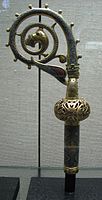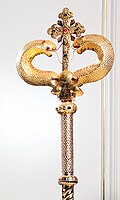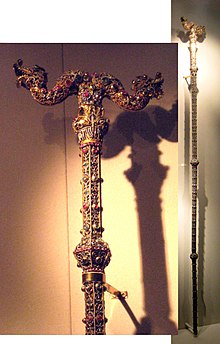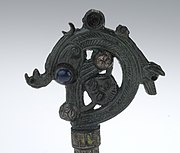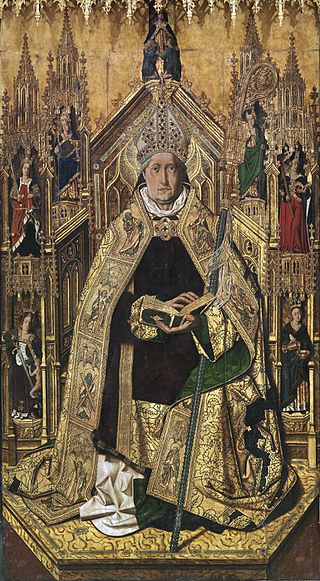
Abbot is an ecclesiastical title given to the head of an independent monastery for men in various Western Christian traditions. The name is derived from abba, the Syriac form of the Hebrew ab, and means "father". The female equivalent is abbess.
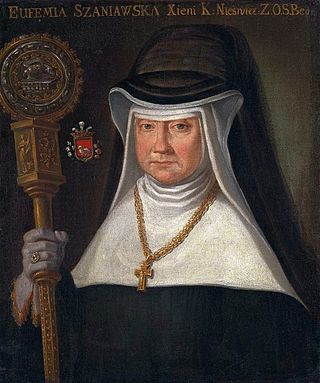
An abbess, also known as a mother superior, is the female superior of a community of Catholic nuns in an abbey.
A bishop is an ordained member of the clergy who is entrusted with a position of authority and oversight in a religious institution. In Christianity, bishops are normally responsible for the governance and administration of dioceses. The role or office of the bishop is called episcopacy. Organizationally, several Christian denominations utilize ecclesiastical structures that call for the position of bishops, while other denominations have dispensed with this office, seeing it as a symbol of power. Bishops have also exercised political authority within their dioceses.

A staff of office is a staff, the carrying of which often denotes an official's position, a social rank or a degree of social prestige.
A pastor is the leader of a Christian congregation who also gives advice and counsel to people from the community or congregation. In Lutheranism, Catholicism, Eastern Orthodoxy, Oriental Orthodoxy and Anglicanism, pastors are always ordained. In Methodism, pastors may be either licensed or ordained.

A candy cane is a cane-shaped stick candy often associated with Christmastide, as well as Saint Nicholas Day. It is traditionally white with red stripes and flavored with peppermint, but the canes also come in a variety of other flavors and colors.

An altar server is a lay assistant to a member of the clergy during a Christian liturgy. An altar server attends to supporting tasks at the altar such as fetching and carrying, ringing the altar bell, helping bring up the gifts, and bringing up the liturgical books, among other things. If young, the server is commonly called an altar boy or altar girl. In some Christian denominations, altar servers are known as acolytes.

The mitre or miter is a type of headgear now known as the traditional, ceremonial headdress of bishops and certain abbots in traditional Christianity. Mitres are worn in the Catholic Church, Eastern Orthodox Church, Oriental Orthodox Churches, the Anglican Communion, some Lutheran churches, for important ceremonies, by the Metropolitan of the Malankara Mar Thoma Syrian Church, and also, in the Catholic Church, all cardinals, whether or not bishops, and some Eastern Orthodox archpriests.
Hegumen, hegumenos, or igumen, is the title for the head of a monastery in the Eastern Orthodox and Eastern Catholic Churches, or an archpriest in the Coptic Orthodox Church, similar to the title of abbot. The head of a convent of nuns is called a hegumenia or igumeni. The term means "the one who is in charge", "the leader" in Greek.

A pectoral cross or pectorale is a cross that is worn on the chest, usually suspended from the neck by a cord or chain. In ancient and medieval times pectoral crosses were worn by both clergy and laity, but by the end of the Middle Ages the pectoral cross came to be a special indicator of position worn by bishops. In the Roman Catholic Church, the wearing of a pectoral cross remains restricted to popes, cardinals, bishops and abbots. In Eastern Orthodox Church and Byzantine Catholic Churches that follow a Slavic Tradition, priests also wear pectoral crosses, while deacons and minor orders do not. The modern pectoral cross is relatively large, and is different from the small crosses worn on necklaces by many Christians. Most pectoral crosses are made of precious metals and some contain precious or semi-precious gems. Some contain a corpus like a crucifix while others use stylized designs and religious symbols.
A sudarium (Latin) was a "sweat cloth", used for wiping the face clean. Small cloths of various sorts, for which sudarium is a general term, played a role in Ancient Roman formal manners and court ceremonial, and many such uses transferred to Christian liturgical usage and art. In Jewish usage, it is the cloth-like habit worn by Jewish men after a wedding, wrapped around the head, and usually worn with a central hat.

Ecclesiastical heraldry refers to the use of heraldry within Christianity for dioceses, organisations and Christian clergy. Initially used to mark documents, ecclesiastical heraldry evolved as a system for identifying people and dioceses. It is most formalized within the Catholic Church, where most bishops, including the Pope, have a personal coat of arms. Clergy in Anglican, Lutheran, Eastern Catholic and Eastern Orthodox churches follow similar customs, as do institutions such as schools and dioceses.
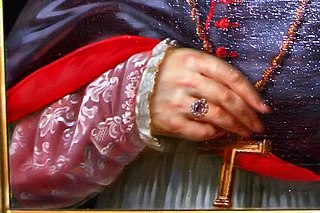
An ecclesiastical ring is a finger ring worn by clergy, such as a bishop's ring.
Pontifical vestments, also referred to as episcopal vestments or pontificals, are the liturgical vestments worn by bishops in the Catholic, Eastern Orthodox, Oriental Orthodox, Anglican, and some Lutheran churches, in addition to the usual priestly vestments for the celebration of the mass, other sacraments, sacramentals, and canonical hours. The pontifical vestments are only worn when celebrating or presiding over liturgical functions. As such, the garments should not be confused with choir dress, which are worn when attending liturgical functions but not celebrating or presiding.

A blessing cross is a hand cross held by a priest or bishop in Eastern Christianity when he gives a benediction. It is often made of precious metal and may be adorned with enamelwork, and precious or semi-precious gemstones. The cross may also have other icons on it, such as the Theotokos, John the Baptist, the Four Evangelists or Prophets.
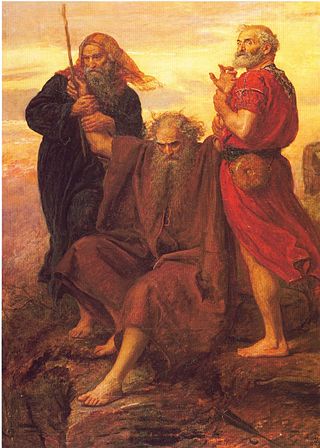
The Staff of Moses, also known as the Staff of God, is mentioned in the Bible and Quran as a walking stick used by Moses. According to the Book of Exodus, the staff was used to produce water from a rock, was transformed into a snake and back, and was used at the parting of the Red Sea. Whether the staff of Moses was the same as the staff used by his brother Aaron has been debated by rabbinical scholars.

The papal ferula is the pastoral staff used in the Catholic Church by the pope. It is a rod with a knob on top surmounted by a cross. It differs from a crosier, the staff carried by other Latin Church bishops, which is curved or bent at the top in the style of a shepherd's crook.
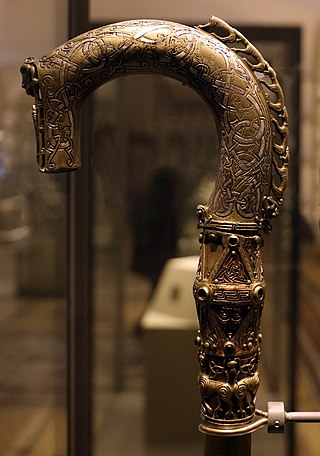
An Insular crozier is a type of processional bishop's staff (crozier) produced in Ireland and Scotland between 800 and 1200. Such items can be distinguished from mainland European types by their curved and open crooks, and drop. By the end of the 12th century, production of Irish croziers had largely ended, but examples continued to be reworked and added to throughout the Romanesque and Gothic periods. Although many of the croziers are associated with 5th- and 6th-century saints, the objects were not made until long after the saints had died. A majority originate from around the 9th century, and were often used as embellishment between the 11th and 13th centuries.

The Clonmacnoise Crozier is a late-11th-century Insular crozier that would have been used as a ceremonial staff for bishops and mitred abbots. Its origins and medieval provenance are unknown. It was likely discovered in the late 18th or early 19th century in the monastery of Clonmacnoise in County Offaly, Ireland. The crozier has two main parts: a long shaft and a curved crook. Its style reflects elements of Viking art, especially the snake-like animals in figure-of-eight patterns running on the sides of the body of the crook, and the ribbon of dog-like animals in openwork that form the crest at its top. Apart from a shortening to the staff length and the loss of some inserted gems, it is largely intact and is one of the best-preserved surviving pieces of Insular metalwork.
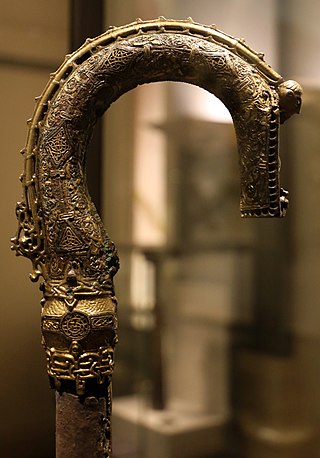
The River Laune Crozier is a late 11th-century Insular crozier, now at the Archaeology branch of the National Museum of Ireland. The object would have been commissioned as a staff of office for a senior clergyman, most likely a bishop. It consists of a wooden core decorated with fitted bronze and silver metal plates. Although the metalwork is somewhat corroded in parts, it is fully intact and considered one of the finest surviving Irish examples, alongside those found at Clonmacnoise and Lismore.

